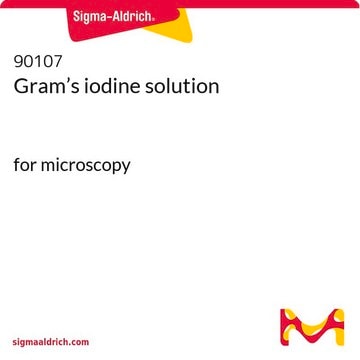8.07270
Phosphorus (red)
(stabilised) for synthesis
Synonyme(s) :
Phosphorus (red)
About This Item
Produits recommandés
Pression de vapeur
<0.1 hPa ( 20 °C)
Niveau de qualité
Forme
powder
Température d'inflammation spontanée
260 °C
Puissance
>15000 mg/kg LD50, oral (Rat)
Pf
585 °C
Densité
2.2 g/cm3
Masse volumique apparente
1100 kg/m3
Température de stockage
2-30°C
InChI
1S/P
Clé InChI
OAICVXFJPJFONN-UHFFFAOYSA-N
Application
- Design of red phosphorus nanostructured electrode for fast-charging lithium-ion batteries: This study proposes red phosphorus as an ideal anode material for fast-charging lithium-ion batteries, demonstrating a red phosphorus-carbon nanocomposite with excellent fast-charging capability and high energy density. (Sun et al., 2019).
- Elemental red phosphorus-based photocatalysts for environmental remediation: A review of low-cost and environmentally benign elemental red phosphorus as a new class of photocatalysts with tunable bandgaps for visible-light response, used in environmental remediation. (Wu et al., 2021).
- Atomically Dispersed Au-Assisted C–C Coupling on Red Phosphorus for CO2 Photoreduction to C2H6: This study explores the use of atomically dispersed gold on red phosphorus for the photocatalytic reduction of CO2 to ethane, highlighting the potential of red phosphorus in photocatalytic applications. (Ou et al., 2022).
- Rapid biofilm eradication on bone implants using red phosphorus and near‐infrared light: This research reports on the use of red phosphorus for rapid biofilm eradication on bone implants when exposed to near-infrared light, presenting a new method for medical applications. (Tan et al., 2018).
Remarque sur l'analyse
Mention d'avertissement
Warning
Mentions de danger
Conseils de prudence
Classification des risques
Aquatic Chronic 3 - Flam. Sol. 2
Code de la classe de stockage
4.1B - Flammable solid hazardous materials
Classe de danger pour l'eau (WGK)
WGK 3
Point d'éclair (°F)
Not applicable
Point d'éclair (°C)
Not applicable
Certificats d'analyse (COA)
Recherchez un Certificats d'analyse (COA) en saisissant le numéro de lot du produit. Les numéros de lot figurent sur l'étiquette du produit après les mots "Lot" ou "Batch".
Déjà en possession de ce produit ?
Retrouvez la documentation relative aux produits que vous avez récemment achetés dans la Bibliothèque de documents.
Les clients ont également consulté
Notre équipe de scientifiques dispose d'une expérience dans tous les secteurs de la recherche, notamment en sciences de la vie, science des matériaux, synthèse chimique, chromatographie, analyse et dans de nombreux autres domaines..
Contacter notre Service technique












